IMPORTANT UPDATE MARCH 14, 2024
Ever since the founding of Ming Dynasty, the Chinese had been an avid user of rocket weapon. Early Ming Dynasty rocket cart could have an upward of six hundred rockets, but subsequent redesigns reduced the number of rockets to make the cart more mobile.
Huo Jian Che (火箭車, rocket cart)
 |
| Drawing of a Huo Jian Che, from 'Si Zhen San Guan Zhi (《四鎮三關志》)'. |
Ye Meng Xiong's Qing Che (輕車)
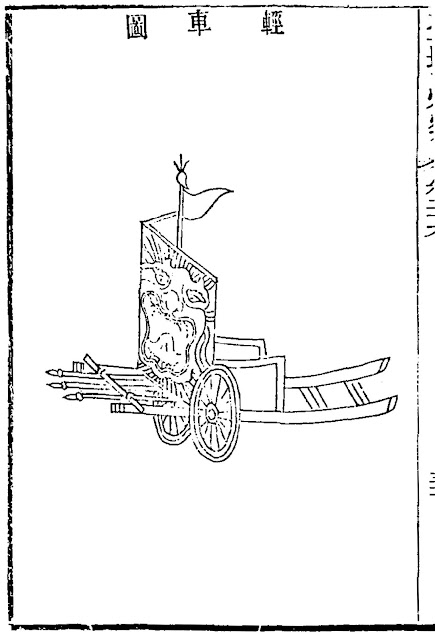 |
| Drawing of Ye Meng Xiong's war cart, from 'Deng Tan Bi Jiu (《登壇必究》)'. |
For more details on Qing Che, see my other post.
Huo Gui Gong Di Che (火櫃攻敵車, lit. 'Enemy-assaulting cart with fire cabinet')
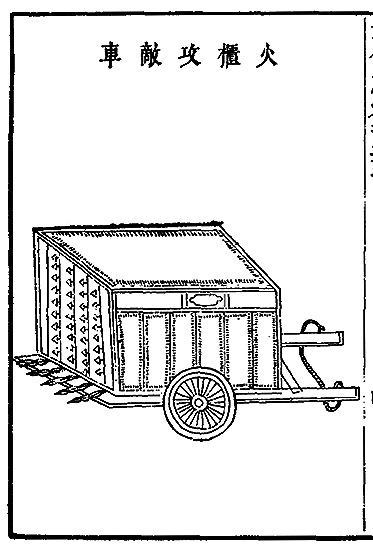 |
| Drawing of a Huo Gui Gong Di Che, from 'Wu Bei Zhi (《武備志》)'. |
Chong Lu Cang Lun Che (衝虜藏輪車, lit. 'Hidden wheel cart of barbarian-charging')
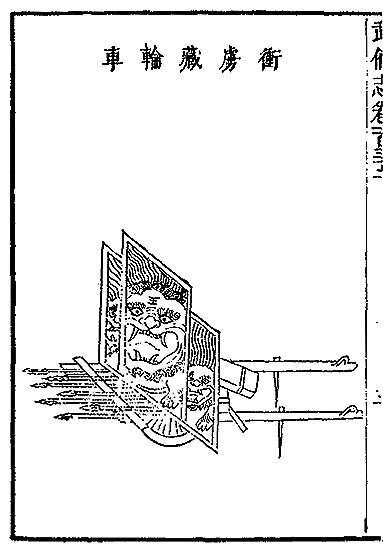 |
| Drawing of a Chong Lu Cang Lun Che, from 'Wu Bei Zhi (《武備志》)'. |
Jia Huo Zhan Che (架火戰車, lit. 'Chariot of fire rack')
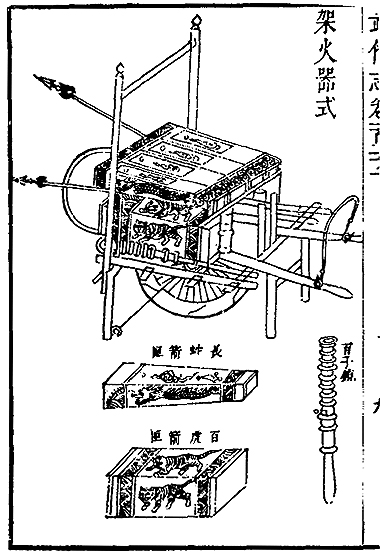 |
| A Jia Huo Zhan Che and its various armaments, from 'Wu Bei Zhi (《武備志》)'. |
Perhaps the most well known of the Ming Dynasty multiple rocket launchers, Jia Huo Zhan Che or "rocket wheelbarrow" as it is known in the West is an extremely versatile weapon platform. It incorporates four pods of Chang She Po Di Jian (長蛇破敵箭) of thirty rockets per pod, and two pods of Bai Hu Qi Ben Jian (百虎齊奔箭) of one hundred rockets per pod, for a total of 320 rockets. In addition, it has three Bai Zi Chong (百子銃), two fixed spears, and a cotton curtain to defend against arrows.
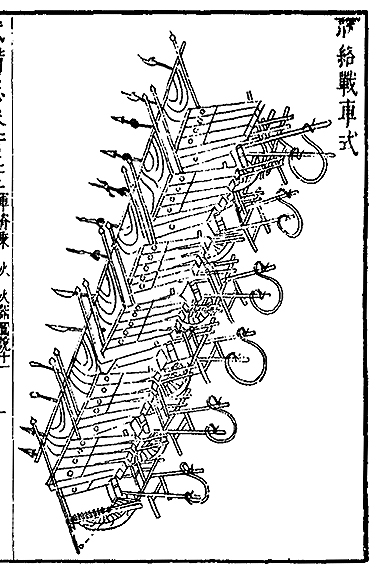 |
| Linked Jia Huo Zhan Che, from 'Wu Bei Zhi (《武備志》)'. |
The versatility of Jia Huo Zhan Che lies in its modular design. Unlike other multiple rocket launchers that are usually one-shot weapons, Jia Huo Zhan Che can quickly replenish its rockets by replacing spent rocket pods with fresh ones. The rocket pods and anti-personnel guns can also be detached and used as standalone weapons. On top of that. several Jia Huo Zhan Che can be chained together to form a mobile fortification similar to a wagon fort.
Gai Shi Wu Gang Che (改式武剛車, 'Modified Wu Gang Che')
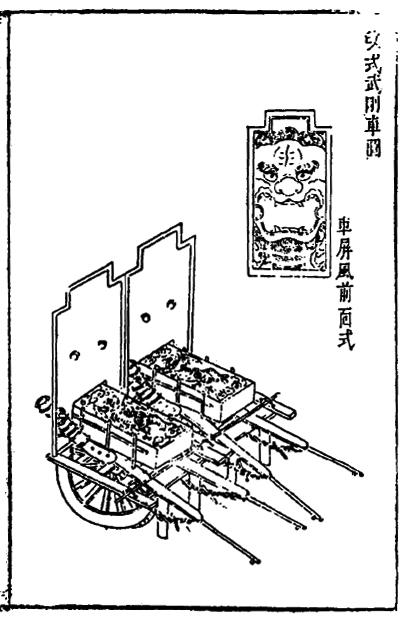 |
| Gai Shi Wu Gang Che, from 'Jun Qi Tu Shuo (《軍器圖說》)'. |
This weapon is named after Wu Gang Che (武剛車), a Han Dynasty horse-drawn cart famously used by general Wei Qing (衛青) to defend against nomadic Xiongnu cavalry.
Oftentimes, any mention of Chinese Huo Che will inevitably bring about the comparison with Korean Hwacha (and vice versa). With national pride at stakes, such discussions often devolve into meaningless bickering and insults about "We invented it first!" and "My Huo Che/Hwacha is better than yours!" Nevertheless, while this kind of online one-upmanship is completely pointless, I will still try to track down the earliest historical references to both Huo Che and Hwacha, and hopefully clear up some confusions.
The first recorded use of Ming Dynasty Huo Che dates to 1401 [1], during the final phase of Jingnan Campaign. Since no detailed description of Jing Nan Campaign Huo Che can be found, this cannot be used as a proof of the existence of a Chinese rocket cart in the early fifteenth century. In 1449, a fletcher named Zhou Hui Tong (周回童) designed a new war cart equipped with six hundreds Shen Ji Jian (神機箭, lit. 'Divine engine arrow'), which was then tested and accepted into mass production [2]. Unfortunately, this too cannot be used as definite proof of the existence of Chinese rocket cart, as Shen Ji Jian in this context refers to unpowered gun darts for Shen Qian (神鎗) handgonnes mounted on the war cart, rather than rockets. The earliest known Chinese rocket cart was a rocket wheelbarrow known as Quan Shen Zhan Huo Qing Che (全勝戰火輕車, lit. 'Complete victory fire light war cart') designed by Liu Tian He (劉天和) in 1536 [3].
EXTRA: Huo Che (火車) and Hwacha (화차 or 火車) debate
 |
| Scale model of a Jia Huo Zhan Che, displayed in National Museum of China. |
The first recorded use of Ming Dynasty Huo Che dates to 1401 [1], during the final phase of Jingnan Campaign. Since no detailed description of Jing Nan Campaign Huo Che can be found, this cannot be used as a proof of the existence of a Chinese rocket cart in the early fifteenth century. In 1449, a fletcher named Zhou Hui Tong (周回童) designed a new war cart equipped with six hundreds Shen Ji Jian (神機箭, lit. 'Divine engine arrow'), which was then tested and accepted into mass production [2]. Unfortunately, this too cannot be used as definite proof of the existence of Chinese rocket cart, as Shen Ji Jian in this context refers to unpowered gun darts for Shen Qian (神鎗) handgonnes mounted on the war cart, rather than rockets. The earliest known Chinese rocket cart was a rocket wheelbarrow known as Quan Shen Zhan Huo Qing Che (全勝戰火輕車, lit. 'Complete victory fire light war cart') designed by Liu Tian He (劉天和) in 1536 [3].
 |
| Blueprint of a Hwacha that can be equipped with either a rocket pod or a volley gun, from 'Gukjo Oryeui Seorae (《국조오례의서례》 or 《國朝五禮儀序列》)'. |
Thus, based on written records, Korean version came first.
(Note: My apologies. I previously mistook the mention of Shen Ji Jian in Zhou Hui Tong's war cart as evidence that Chinese invented rocket cart in 1449, which is incorrect. While the term Shen Ji Jian did exclusively refer to rocket from sixteenth century onward, its meaning was far less precise in the fifteenth century. I have since corrected the description.)
Relevant sources
Ming Dynasty
1.《奉天靖難紀》上先以三騎覘賊陣,見其火車、火器、強弩、戰楯悉列陣前,遂掠賊軍而過。
2.《明實錄 · 英宗實錄》
順天府箭匠周回童言:『軍中所用神機短槍,人執一把不能相繼。臣請為車一輛,上安四板箱,內藏短槍二十把,神機箭六百枝。臨用將槍五把安車上,為叉以駕之,叉亦可禦敵。槍多可相繼而發。車止用四人,一人推,兩人傍扶,一人隨釁,其於人執一槍發,輙不繼者,功相十五。』奏入,帝令武清侯石亨試其可用而後造之。
3. 《皇明經世文編》
命紘取名全勝車。今幸存破損八輛。略備規制臣因再加損益其制輪高三尺一寸。夾輪轅四尺七寸二分。下施四足。前二釘以圓鐵轉軸。行則懸之。左右箱各廣九寸五分。於上安熟鐵小佛郎機一。及流星炮。或一窩蜂一。箱上為架。用安銅鐵神槍一。及各邊近年所造三眼品字鐵銃一。飛火槍筒一。箱之四角。插倒馬長槍開山巨斧各二。斬馬刀鐃鉤各一。並火藥鉛子釽钁鹿角等器。通不過重一百五十餘斤箱前樹獸面牌繪以虎貌之象。兩面各挂虎頭挨牌。戰則張之以蔽矢。兩車相連。可蔽三四十人。每車二人輪推之。一人挽之。二人翼之戰則各隨地形。環布為陣。馬軍居中。敵遠則使火器。稍近則施疆帑弓矢。逼近則用槍斧鉤刀。
Joseon Dynasty
4.《朝鮮實錄 · 太宗實錄》賜軍器少監李韜、監丞崔海山馬各一匹。上御解慍亭, 觀放火車,有是賜。又賜布五十匹于火桶軍。火車之制,以鐵翎箭數十,納諸銅桶,載於小車,以火藥發之,猛烈可以制敵。
5.《朝鮮實錄 · 文宗實錄》
先是上命臨瀛大君璆,制火車。其車上設架子,插置中神機箭一百箇,或置四箭銃筒五十箇,以火炷之,連次而發。
Apologies for going off topic since you mentioned the 四鎮三關志,I was wondering what kind of hat is depicted in the military treatise.
ReplyDeletehttp://i.imgur.com/QHeMWuA.png?1
I'm guessing its some sort of 氈笠(Felt hat?) that also appears in 平番得勝圖.
Seeing as how I have digressed from the topic of mobile rocket carts is there any way I can contact you outside this blog?
Those hats are supposedly called 大帽. You can find more information here (http://www.xn--rhtw9vlu4bfqe.tw/EastCapital/viewthread.php?tid=2633). I assume you can read Chinese?
ReplyDeleteATM I only use this email account for the blog though.
Does these rocket cart also use for siege purpose?
ReplyDeleteUncertain. Rocket was certainly used, but whether they were launched from carts or fixed platform was not known.
DeleteWhat's your conclusion about the Huo Che/Hwacha debate? Do you consider them as separate developments or did they influence each other?
ReplyDeleteThe debate is pointless, since most debaters can't even get the name of Chinese rocket cart straight (Huo Che is NOT the Chinese name for rocket cart). Also, mounting rocket on mobile platform is not rocket science (pun very much intended), everyone can do it.
DeleteMy bad, I mean Huo Jian Che. So basically what you're saying is that they are separate developments totally unrelated to one another, is that correct? And also, why only the Chinese and the Koreans used rocket arrows to such great extent, but not other cultures?
DeleteI do not rule out the possibility of Chinese influencing Korean design (since chronologically Chinese had it first), but we need more evidence other than chronological order to "prove" that. Again, as long as you have the means to build rocket and cart, marrying two together into one weapon isn't some sort of super unique idea.
DeleteAs for why only Chinese & Korean make us of rocket around this period, I think that has to had something to do with the archery culture of Chinese and Korean people (i.e. abundance of arrow maker). Just a guess though.
DeleteWell. For me it is just obvious where the koreans got their rocket technology from and 15th century technological achievements Eunuchs and "Exchange Students".
DeleteThe Mongols and the Kingdom of Goryeo became linked via marriage and Goryeo became a quda (marriage alliance) state of the Yuan dynasty; monarchs of Goryeo during this period were effectively imperial sons in-law (khuregen). Goryeo provided palace women, eunuchs, Buddhist monks, and other personnel to the Mongols. Korean concubines were procured by the Khan. One of them was Empress Gi, who, through her political command and incorporation of Korean females and eunuchs in the court.
It became prestigious to marry Korean women among members of the Yuan elite. In addition, their Mongol wives, and even concubines, exerted great influence over Goryeo politics. Sino-Korean relations were amiable, and Korean envoys' seating arrangement in the Ming court was always the highest among the tributaries. Korean eunuchs enjoyed more power than any other foreign group in the ming court
Some fifty korean students took examination from 1315 to 1354. Although the first few Ming emperors resumed the practice of accepting Korean students to study in China, the number of students decreased greatly, compared to that of the previous dynasties. In the middle of the Ming Dynasty, the emperor even declined the Korean government’s request to continue sending students to China. Jang Yeong-sil traveled to China to study the various designs of water clocks.
How were gun/cannon arrows called in the ming dynasty?
ReplyDeleteI mean the first reference to rocket-like weapons in europe and Japan is about the mongols
DeleteAn illustration from the Krieg Technik of the 1420–40s:
http://imgur.com/gallery/f8HlzQ0
somewhat logical since the oldest known depictions of cannons in the west are indeed 'rockets', more precisely gun arrows
Top: "De Nobilitatibus, Sapientii et Prudentiis Regum", manuscript, by Walter de Milemete, 1326
Bottom: uncompleted drawing from Aristotle's "De Secretis Secretorum", manuscript, attributed to Milemete, 1326:
http://imgur.com/gallery/hgv8uyH
Burg Eltz in Germany was besieged by Baldwin, Archbishop of Trier, in 1331. Two gun arrows in the castle armoury have been definitively dated to the time of the siege; one may be of an earlier date and was recycled as a gun arrow. The shafts are of oak, the flights of copper and the heads of iron. The longer is 67cm in length and the shorter 54cm, with a diameter at the rear of
3cm.
http://imgur.com/gallery/SaPR8hs
here we have bo-hiya
https://ja.wikipedia.org/wiki/ファイル:Bo_hiya_fire_arrow.JPG
And:
https://commons.wikimedia.org/wiki/File:Chongtongs-Jinju_Castle.jpg#mw-jump-to-license
Incendiary arrows fired from metal tubes are clearly as old as the 13th century.
Gun arrow was called Chong Jian (銃箭) in Chinese.
DeleteLooks like the Joseon chongtong. Is there any available illustration from the ming military treatises for 銃箭?
DeleteNo except the one from Shen Qiang (and a few other handgonne-sized dart guns).
DeleteThis comment has been removed by the author.
Delete